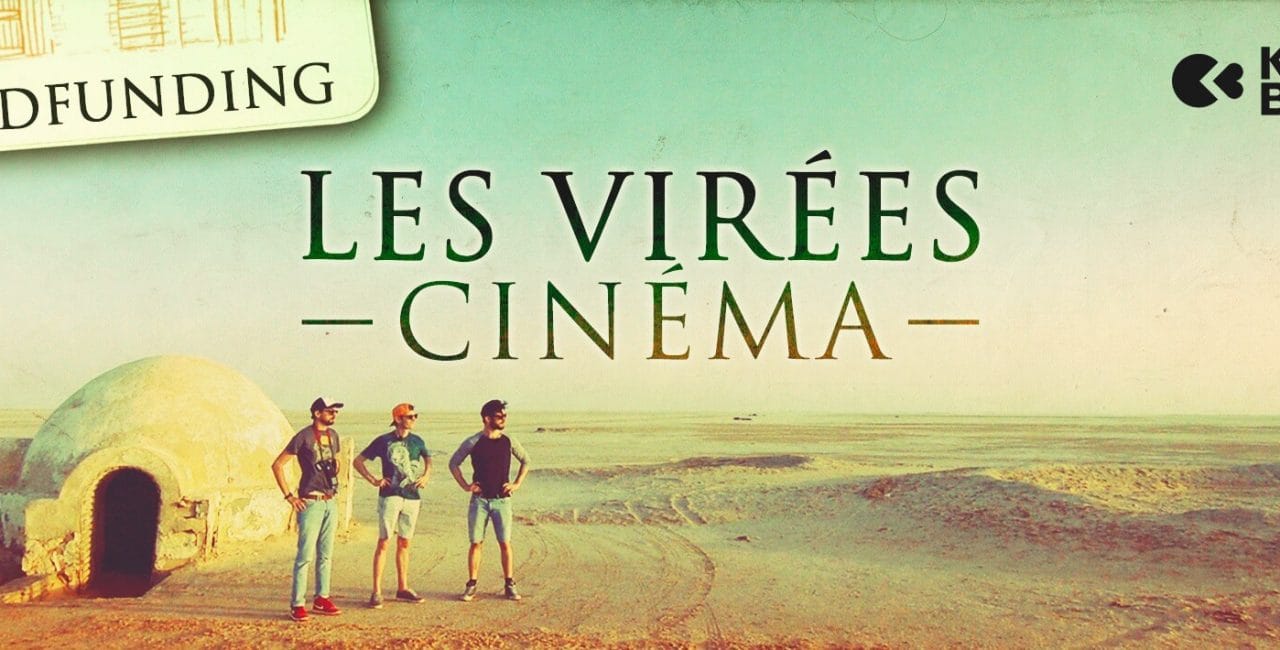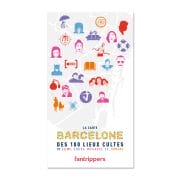Article
Les Virées cinéma, a fabulous trip to the filming locations

Better known as the Film Gravedigger, named after his Youtube channel launched in 2012 and with more than 735,000 subscribers, François Theurel tells the story of cinema with a unique tone, combining sharp analysis, relevant humour and a narration accessible to all. Holder of a PhD in information and communication sciences, this specialist in the 7th Art wishes to share his passion through Les Virées cinéma, a high quality video series on emblematic filming locations around the world. A project to support absolutely on KissKissBankBank.
How were Movie Trips born?
Originally, the idea came with the Captain of Nexus VI, the other Youtube channel dedicated to science fiction. In 2017, we went together on holiday to Spain in the province of Almeria because a few months earlier we had discussed the many films shot there, especially the spaghetti westerns, those of Sergio Leone… I suggested that we take the car to go to as many filming locations as possible, taking my camera, of course. My idea was simply to film and make a video for my channel if there was enough material. That’s how the first road trip was born. We discovered a lot of places by covering a large distance and the concept came to us because each time we recognized the place but we wondered why it appeared to us in a different way than on the screen. For example, the beach where the famous Indiana Jones scene and the last crusade where Sean Connery makes the birds that are going to destroy a plane fly away, is much more spaced out in reality. On the screen, it appears narrow to signify that the characters are trapped. The idea was to analyse in a playful way how you change a place on the screen, how you cheat with it and how the language of cinema is made. I then made a second trip in early 2018 to Las Vegas when TCM Cinema offered me to do something about Ocean’s Eleven.
What is the concept of the series?
There’s really a lot of potential to do something that doesn’t just go out there and say “it’s there”, even if that’s what you do in some places, but to have a more global reflection on cinema. We can talk in a more technical and playful way, and each episode should be themed around a major cinematic issue in order to help people discover each country from a more particular angle. I really wanted to play on several different aspects by proposing something that is both documentary, that certain scenes are a bit fictionalized and that we also make images by recreating certain shots by wondering what focal length was used, with what technique or what light? All this allows you to write homogeneous and very dynamic episodes. That’s what we did with my good friends at Pandora Creation to launch this in 2019. The first four episodes were financed with various grants, notably from the Centre National du Cinéma, the Provence Alpes Côte d’Azur region and Radio Télévision Suisse. Arte was initially supposed to be in the same category but this did not happen for various reasons and when the channel withdrew from the project, we wanted to rely on crowdfunding to finish this season, which should have a total of eight episodes.
“I don’t want to dissect everything, I rather want to be able to show what goes on behind the scenes while pursuing our dream of cinema with a slightly poetic dimension.”
You make discover many things through this series. What is most important to you?
Discovery. Discover places, anecdotes, ways to cheat. I think everyone is aware that cinema is an art of cheating to create a very real emotion and I like to lift the veil a little on this subject without desacralizing things. I don’t want to dissect everything, I rather want to be able to show what goes on behind the scenes while pursuing our dream of cinema with a slightly poetic dimension.
The first season focuses on the Maghreb, Ireland, Switzerland, New Zealand, the Amazon, Louisiana, the North West of the USA and Los Angeles. How were the destinations chosen?
It was mostly done out of a crush. New Zealand and the Maghreb were the obvious choice because of the large number of films shot there. I like to introduce a lot of people to them, but I also like to have leading figures talking to a lot of people. For example, when you have Star Wars, Game of Thrones or The Lord of the Rings, it’s immediately easier to get people on board and let them discover things that are less well-known. There were some great references that I wanted to talk about. Los Angeles will be the last trip, because I’m interested to know what cinema is today. He has changed so much that I am unable to answer that question now. So finishing up in Hollywood and asking this question in the Mecca of cinema can be interesting. There are also countries that have been given more thought. For example, in the beginning we were supposed to go on a trip to France, and Radio Télévision Suisse came in the loop by offering to help us on condition that we dedicate an episode to Switzerland. It was therefore decided to replace France with Switzerland. I liked the challenge because I had to find an angle on a country that was a little less attractive for big productions but which had seen a lot of filming. Beyond the clichés we had about Switzerland, we had to show what was behind it. All this was decided according to desires and inspirations. I had different themes that I wanted to talk about such as, for example, magic and cinema. It speaks to me a lot and I’ve dedicated another format to it, called Camera Obscura.
What about the Amazon?
I think it’s my Werner Herzog fan side. However, we will see, for the second part of the season, we may change some destinations. This is also done according to the availability of the guests, authorizations, what is possible or not. Maybe that will change. The Amazon has that adventurous side. When you live and work in such a harsh environment, how does it permeate the images shot on location? I want to experience that very much. We’ll see how we turn this around. I have a little idea and if it works, I would be very happy.
Depending on the destination, you are accompanied by PV Nova, Mathieu Pradalet (French Food Porn), Alt236, Flore Maquin, Le Captain de Nexus VI, Aude GG, the Chroma team. Why was it important for you to have a different guest on each episode?
The relationship we have with cinema and places is very intimate, but it is also above all a collective experience. So I thought it was interesting to do a narrative from my perspective, but I liked the idea of also having someone else’s who may have a different view of the place and have their own cinematic memories, with a different culture from mine on some points. I like the idea that it’s watering down the rides and that each guest brings their own perspective. For example, on the first trip to the Maghreb, PV Nova makes an insert on desert music and brings a light that I wouldn’t have given myself. The idea is really to have a complementary look each time to give each destination a particular hue.
Would you like to focus only on the great films or do you also think you’ll evoke more intimate works?
It’s not a question of big or small, but rather what a place has to say. He has to be visually interesting and tell things. There are a lot of very interesting films, but there won’t necessarily be much to say about where they were shot. There is also an arbitrary aspect to the fact that certain places speak to me more and I would be more telling about them. That’s also why I like to look at things from a different perspective, because it gives me a different reading grid and takes me to areas I would not have explored if I had been alone.
The first season will have eight episodes. Would you consider it a second?
We don’t know yet. Of course we would like to go further but we will start by going to the end of the first season and then see what happens.
How do you work, both upstream and on-site?
There’s a lot of preparation. First of all, logistics to locate the places, choose them, obtain the authorizations, see how to get there. There is also a thematic aspect, since I am starting from a rather precise idea. For Switzerland, for example, it seemed good to me to have the back of the postcard. But the idea is also to do according to the surprises on the spot. I really hope to have some so that the video can drink from it by rubbing up against the reality of the place. Once the shooting is over, I can write a script with my voice-over based on the interviews and discoveries made on location. It’s not easy, it’s another writing exercise compared to what I usually do, but it’s very interesting.
How do you find the information on the premises?
I’m trying to glean information from where it is. I don’t have a set formula, I do what I can. Most of it is on the internet but you have to be careful because a lot of things are circulating and there is sometimes false information. Overall I try to adapt to each trip. Sometimes there’s a very interesting challenge. For example the spot where Werner Herzog had the boat pulled on the hill in the Amazon in Fitzcarraldo, it is not easy to find. I managed to do it and I like to struggle a little bit, it gives a special feeling. We tell ourselves that we deserve to go there because we’ve been through so much to find it.
And it doesn’t stop there, sometimes on the spot there remains one last difficulty to overcome: finding the right angle of view to be faithful to the camera…
Exactly. Exactly. It happened to us on the first trip with the Captain of the Nexus VI to Almeria. We found the mountain in Conan the Barbarian…
This treasure hunt side often gives a very special thrill…
That’s right. The places with the most important memories are always the ones that were hardest to find. Then there’s an intimate side to it. In the episode on the Maghreb, when we find the igloo of the Skywalker family
You also talk about the problems encountered during filming, thus moving the viewer to the other side of the screen?
Totally. We often idealize the cinema but sometimes there are considerations that we don’t think about. For example we were recently in New Zealand and we went to Elephant Rocks, which is a kind of plain with lots of incredible rocks and where epic movies were shot, but it’s studded with sheep droppings! Just this kind of thing is very funny to see because you can imagine the film crew rushing to shovel sheep droppings two weeks before the scene is shot.
Of all the destinations you’ve visited, does one place embody The Land of Cinema more than the others?
From the outside, I would say New Zealand, and that’s one of the axes of the video I’m writing. But in the way I felt, the Maghreb was still something. It was also the first time, there was freshness and we really had an adventure. It’s not the land of cinema in the sense that it’s the most equipped to accommodate a lot of filming, but in the imagination that it carries, starting with Star Wars, The English Patient and all those films that mattered to a lot of people, there was something there. But I’m not objective because the desert does things to me.
“We want to run this project with true audio-visual quality.”
We’re back to the intimate relationship you were talking about…
Exactly. Exactly. For example, when you go to Hobbiton in New Zealand, where the village has been preserved after the filming of the Hobbit, it’s nice to see but there is no intimate relationship at all because the visits are on a chain reaction. So to find things that are much more modest, but which you had more difficulty finding and on which you find yourself alone, it has an incomparable flavour.
What do you think of cinema tourism?
This is a form of tourism like any other. I’m surprised it didn’t develop earlier, but it’s true that it has become popular with the internet. I think there is also a form of misunderstanding about it for some people because it is not as legitimate for some people as going to a museum, but it is becoming more and more democratic, so that is good. It’s a different reading grid. We say this at the end of the episode about Ireland because it gives you a perspective on the place and you probably would never have come there otherwise.
You’ve reached the first level of your crowdfunding campaign. It is a satisfaction because doing quality work requires means, but it is now important to succeed in going further…
Every new euro helps to better finance the people working on this project. We want to carry out this project with real audiovisual quality. The Internet is still in the middle of the pack and some people have told us that it was possible to do this for less money. That is true if everyone works for free, but we want to pay everyone as they should be paid for the work they do. It’s an expensive format, and we want to make the best of it. Whatever happens, we will do the best we can with what we have, but if people can help, it will help us enormously.
The Fantrippers Buying Board

BARCELONA map of the 100 most famous places (French edition)
The Barcelona Fantrippers map, an original way to discover the city of Gaudí! Through 100 places of pop culture, walk its streets from another angle. Movies, TV shows, music, comics and novels, will allow you to spend a pleasant moment in the capital of Catalonia. With a folded format of 10 x 18 cm and an unfolded format of 60 x 54 cm, it can easily be put in your pocket or bag for consultation.
Content quality
Interest for fans
Value for money

By Anthony Thibault
From the "Casimir generation", Anthony has kept (in addition to a passion for Goldorak) a taste for inventive images, experimentation and curiosity. Passionate about travel and pop culture, he co-founded Fantrippers with Nicolas Albert to share his passion with as many people as possible.



